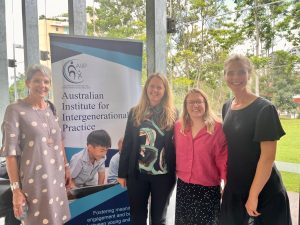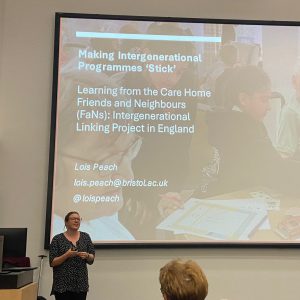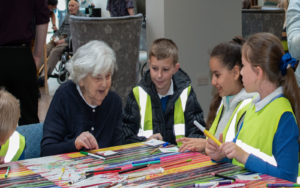Presenting our Intergenerational Linking research to the Australian Institute of Intergenerational Practice
 We were delighted to have our intergenerational research profiled recently at the Australian Institute of Intergenerational Practice’s (AIIP) annual symposium!
We were delighted to have our intergenerational research profiled recently at the Australian Institute of Intergenerational Practice’s (AIIP) annual symposium!
The World Health Organisation’s Global Report on Ageism recognises intergenerational interventions as a way of combatting ageism in our communities.
The prevalence of ageism has widespread consequences for society and for people’s health and wellbeing. Amongst older people, ageism is associated with poorer physical and mental health, increased social isolation and loneliness, and decreased quality of life.
As such, working to develop and improve the sustainability of intergenerational programmes is increasingly significant.
Our intergenerational project ‘Care Home Friends and Neighbours: Intergenerational Linking’ remains England’s biggest intergenerational project with care homes to date!
From 2019 to early 2023, 4,000 young people aged 5-14 from schools and youth organisations connected with approximately 2,000 older people living in care homes, with widespread benefits for participants of all ages. Many of these links still continue to connect today.
Lois Peach – a researcher from the University of Bristol who was involved in our project and a current visiting scholar at Griffith University – presented findings from our research as part of a panel of international speakers at the 2 day conference, held at Griffith University’s Southbank Campus in Brisbane. There was rich insight into a diverse variety of intergenerational interventions in communities, schools, early education and adult care. Academic researchers from health, education, housing, community development, intervention science and other disciplines also showed how intergenerational interventions are helping to create better lives for children, young people, older adults, programme staff and communities.
Our research
 Care Home Friends and Neighbours: Intergenerational Linking ran in 11 areas of England, and was led by a partnership from us at My Home Life England and our colleagues at Bradford-based The Linking Network – experts in Schools Linking and who now have 60 intergenerational links running across Bradford.
Care Home Friends and Neighbours: Intergenerational Linking ran in 11 areas of England, and was led by a partnership from us at My Home Life England and our colleagues at Bradford-based The Linking Network – experts in Schools Linking and who now have 60 intergenerational links running across Bradford.
With the support of a local ‘community broker’ who led the project in their area, a school or youth group was supported to link with a nearby care home over a period of 18 months. The goal was to create meaningful and mutually beneficial intergenerational friendships between younger and older people, and sustainable connections between schools, youth groups and care homes.
Over the course of the project, Lois’ involvement in the research followed these local ‘community brokers’ to see what lessons could be learnt about their facilitatory role in communities. Lois used object interviews, a creative research method, to ask local brokers how they thought their role might help strengthen intergenerational programme sustainability.

Our findings suggest:
- Local community brokers were able to nurture links between schools and care homes by providing advice, activity ideas and administrative support.
- Local community brokers bridged periods of change or turbulence caused by staff shortages or turnover, policy changes and organisational challenges. In this way, they described themselves as the ‘glue’, making links ‘stick’. Although their involvement did not remove the need for committed school and care home leads, this support was significant given the increased demands placed upon education and care sectors during the COVID-19 pandemic.
- Local community brokers supported sustainability.
- By helping to develop strong relationships between schools and care homes; encouraging autonomy in each link; and by being responsive to the different needs of schools and care homes during the 18-month project, local community brokers strengthened links. However, they acknowledged that intergenerational programme sustainability is not a fixed condition, but an interpretive process that requires ongoing support.
- Local community brokers praised the support they received.
- Local community brokers received guidance from the national team (My Home Life England and The Linking Network), monthly Sharing Network meetings between local community brokers, and local and national advisory groups. Together, these factors created a multi-layered systemic approach to developing intergenerational practice in communities.
Takeaways
- Overall, these findings from Care Home Friends and Neighbours Intergenerational Linking’s research suggested that the facilitation of intergenerational practice is key if it is to be sustainable and realised on a national scale in England.
- Local community brokers and the multi-layered framework of support around them bolstered the dedication of passionate individuals delivering intergenerational links and they were able to help navigate external challenges, such as national or regional policy changes, organisational priorities, funding insecurities and interpersonal relationships.
- In this way, local community brokers were able to contribute to intergenerational programme sustainability by coordinating and nurturing links between organisations within their communities.
In a world where fostering deeper and more meaningful connections across all ages is needed, attention needs to be paid to the organisation and coordination of intergenerational practice.
Resources
- For care homes and schools/young people’s groups wanting to set up their own intergenerational link, we have a free practical handbook filled with learnings from the project.
- The full research report and a take-away summary are also available below.
- Watch videos from each of the 11 local areas and find out what they got up to in their links.
- See other resources on the project homepage
With thanks to Lois Peach and the 11 community organisations who led the local projects. Pictured in the top photo are Rosemary Dax; Associate Prof, Clare Littleton (Torrens University), Lois Peach and Anna Glumac (The Herd ILC).
Care Home Friends and Neighbours: Intergenerational inking was funded through the #iwill Fund. The #iwill Fund is made possible thanks to £66 million joint investment from The National Lottery Community Fund and the Department for Digital, Culture, Media & Sport (DCMS) to support young people to access high-quality social action opportunities. The Dunhill Medical Trust acted as a match funder for this project and awarded grants on behalf of the #iwill Fund.

